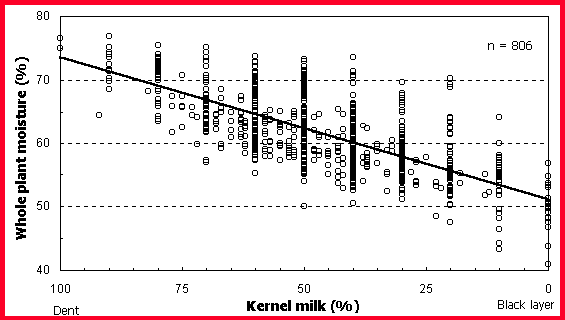April, 1999
Field Crops 28.47-23
Kernel Milkline: How Should We Use It For Harvesting Silage?
Joe Lauer, Corn Agronomist
Corn must be ensiled at the proper moisture to get fermentation for preservation.
But, determining when to harvest corn at the right whole plant moisture is difficult.
Each storage structure properly ensiles at slightly different moisture optimums.
Harvesting corn too wet for the storage structure will result in reduced yield,
souring and seepage of the ensilage, and low intake by dairy cows. Harvesting too
dry reduces yield, can cause mold to develop, and lowers digestibility, protein
and vitamins A and E.
The dilemma is finding an easily measured indicator that accurately correlates with
moisture. One indicator often suggested is whole plant "greenness." But,
there is little relationship between greenness and moisture. The amount of greenness
is subjective and differs among agronomists.
Kernel milkline may be the most widely used indicator for determining when to harvest
corn for silage. One advantage of the kernel milkline is that it indicates the rate
at which the crop is drying down. On average, kernel milkline works fairly well
(regression line in Figure 1). But, like greenness, there seems to be little relationship
between kernel milkline and moisture due to the wide variability at of hybrids at
specific milklines. For example, at 50% kernel milk, some hybrids are too dry, while
others are too wet for proper ensiling (min = 50% moisture, max = 74% moisture).
These observations are also borne out by farmer experience. Many farmers have reported
that harvesting at the recommended 50% kernel milkline is too wet and silos seep.
In the recent past few years, corn silage harvest has often been delayed resulting
in poor dairy cow performance when the corn silage was fed because the kernels were
too mature and passed through the rumen.
How can we use kernel milkline as an indicator for whole plant moisture? The evidence
suggests that we can’t. But, we might be able to use it as a "trigger"
in that once a corn hybrid is at certain kernel milkline stages, farmers should
begin testing the field for whole plant moisture. The triggers vary by silage storage
structure (Table 1). The kernel milkline triggers correlate with moistures too wet
for proper ensiling (more than 95% of the hybrid*environment cases evaluated). Once
the moisture of a hybrid in that field is known, an average moisture drydown rate
of 0.5% per day can be used to predict when to begin harvesting. Furthermore, the
milkline can continue to be monitored to observe whether the rate of moisture loss
is changing dramatically.
|
Table 1. Using kernel milk as a trigger for checking corn whole plant moisture and
predicting silage harvest.
|
|
Silo Structure
|
Recommended moisture content
|
Kernel milk "trigger"
|
|
|
%
|
%
|
|
Horizontal bunker silos
|
70 to 65
|
80
|
|
Bag silos
|
70 to 60
|
80
|
|
Upright concrete stave
|
65 to 60
|
65
|
|
Upright oxygen limiting
|
60 to 50
|
40
|
|
Silage moisture decreases at an average rate of 0.5% per day. Days between early
dent and 50% kernel milk ~12 d; between 50% kernel milk and 0% milk (black layer)
~13 d. "trigger": kernel milk stage to begin checking silage moisture
(90% of HLY)
|
Figure 1. Relationship between whole plant moisture and kernel milk. Each data point
is one hybrid in an environment.
